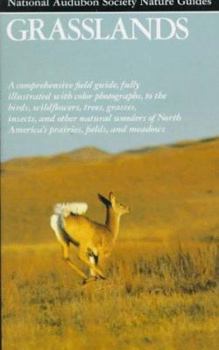National Audubon Society Regional Guide to Grasslands
Select Format
Select Condition 
Book Overview
A comprehensive field guide, fully illustrated with color photographs, to the trees, wildflowers, grasses, insects, birds, and other natural wonders of North America's prairies, fields, and meadows. This description may be from another edition of this product.
Format:Paperback
Language:English
ISBN:0394731212
ISBN13:9780394731216
Release Date:May 1985
Publisher:Alfred A. Knopf
Length:606 Pages
Weight:1.86 lbs.
Dimensions:0.9" x 5.5" x 8.6"
Related Subjects
NatureCustomer Reviews
3 ratings
For Amber Waves of Grain...
Published by Thriftbooks.com User , 16 years ago
If you've ever driven across one of the great prairie states and seen nothing but sorghum or genetically-engineered corn on either side of the road, you may think the words of America the Beautiful are mere chauvinist hyperbole. Visit one of the 20 National Grasslands, however, and you'll share a thrill that the land-hungry pioneers of the 19th C took for granted. Grasslands in flower are as beautiful and as grand as the High Sierras or the red rock canyons of the Southwest. Sadly, they're a good deal more valuable also, once plowed and planted with grain. The result is that grasslands are as close to eradication as wetlands; only a tiny percentage of the grasslands of America are intact today, and the reckless cultivation of Frankenfood and Frankenfuel further endangers the survival of native grasses and of the birds, beasts, and butterflies that thrive on them. Velvet grass, little bluestem, meadowfoam. Calico aster, larkspur, elegant camas, rain lily, buttercup. Ornate tiger, painted lady, swallowtail. Sage grouse, vesper sparrow, American goldfinch. Are the names poetry enough? Evocative of big skies and clover-scented zephyrs? Then you'd better grab this field guide, with its 618 full-color plates, and hasten to your nearest preserved grasslands before the needs of hungry humanity overwhelm them. This is as good a general field guide to the plants and animals of the grasslands as you'll ever find, though if you want to focus intimately on one ecological zone, you'll need a more specific source of info. I've chosen to review this book today, May 30th 2008, after reading in my morning paper that the Mdewakanton tribe, owners of the most prospering casino in Minnesota, has invested a chunk of its new wealth in restoring hundreds of acres of cornfields to native grasslands, within an hour's drive of the Twin Cities. Go, tribe! Next time I visit my home state, I'll be walking in golden alexander and compass plant up to my knees, you betcha!
Very good
Published by Thriftbooks.com User , 23 years ago
This is a very good introduction to American grasslands. If it has any flaws, it's that it tries to do too much with the result that it doesn't do enough. In other words, from a scientific point of view, there may be many similarities between the grasslands east and west of the continental divide. But from a visitors point of view, the short, mixed, and tall grass prairie east of the divide stands alone. Therefore, this guide would have been more useful to me if it had concentrated on one side of the divide or the other, and devoted more text to the grasses on that side. Still, as far as I know, there is no other guide of this kind, so I'm glad to have it.
great reference !
Published by Thriftbooks.com User , 24 years ago
This is an excellent resource -- great photo sections for mammals, trees, flowers, etc found in grasslands. Easy to cross-reference and find information quickly.






